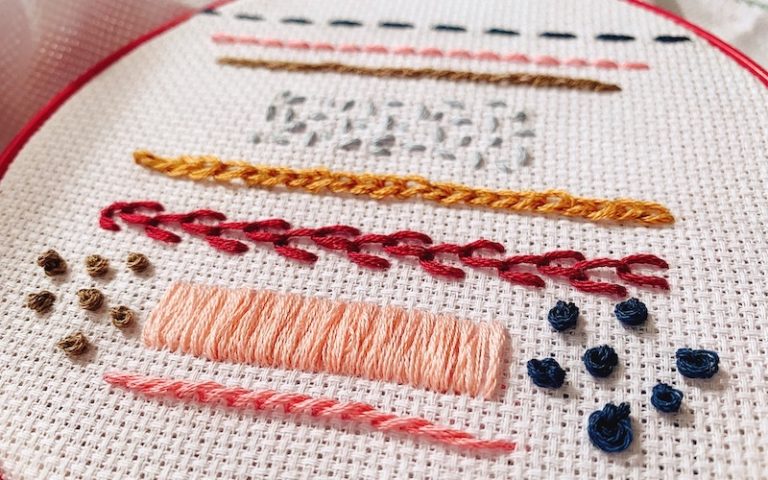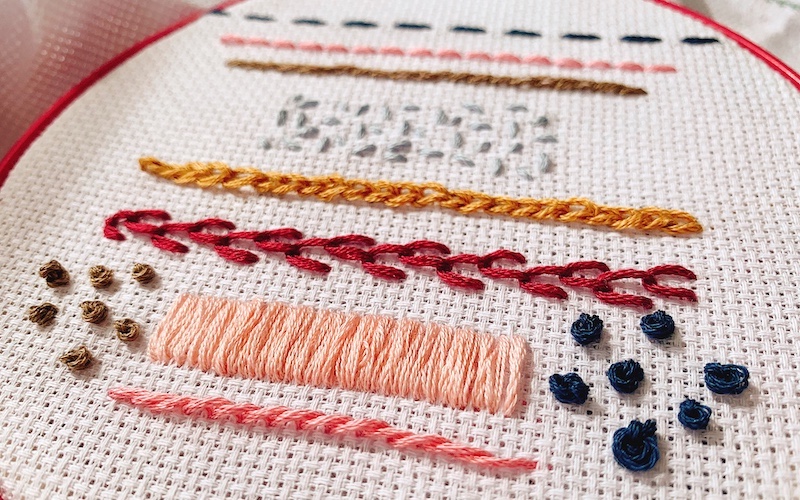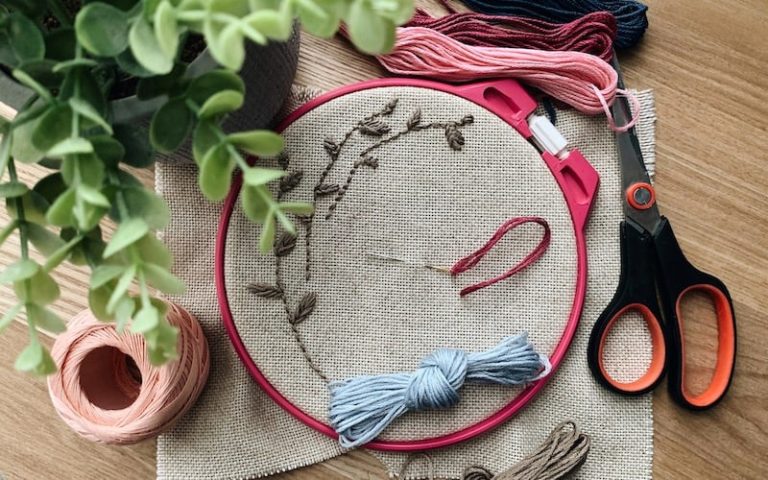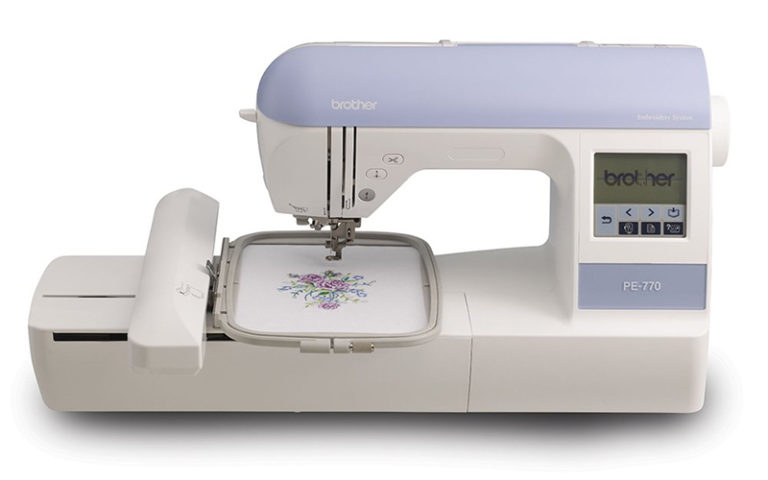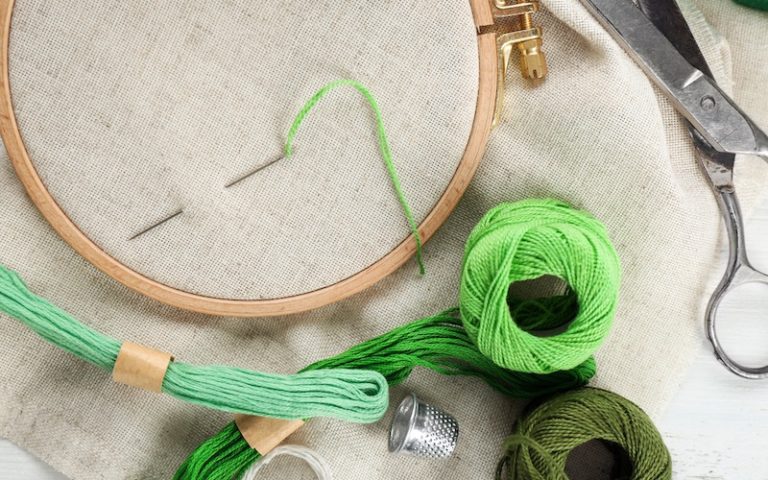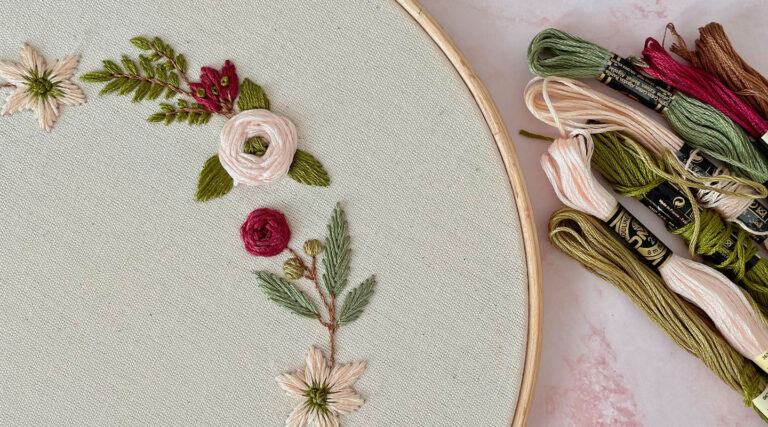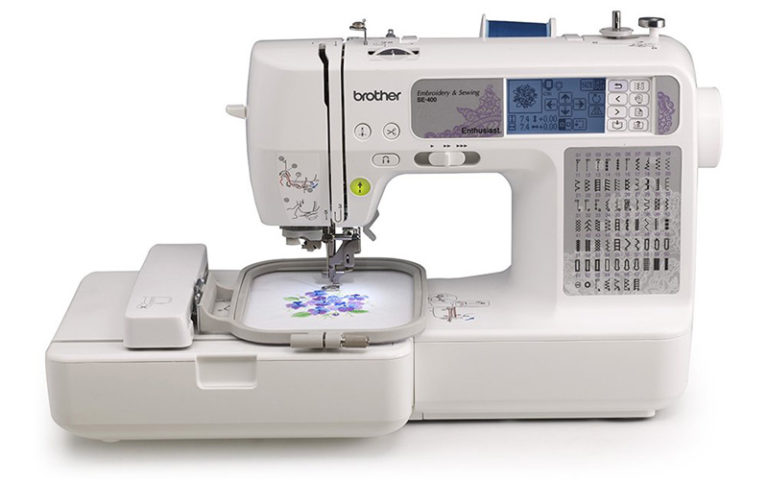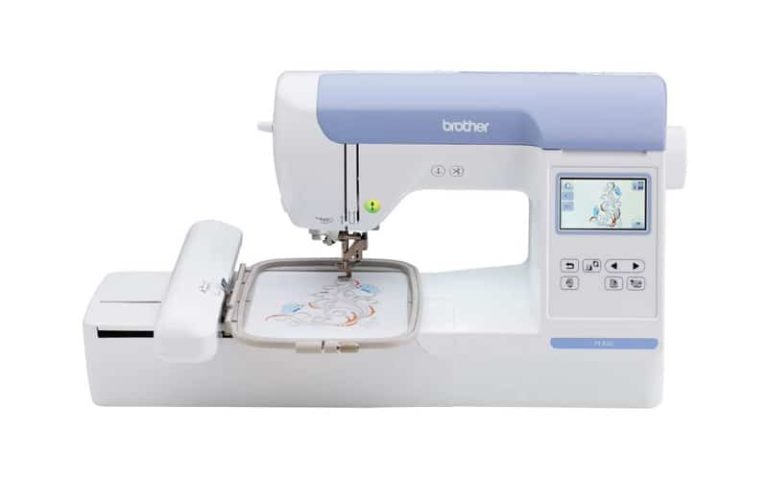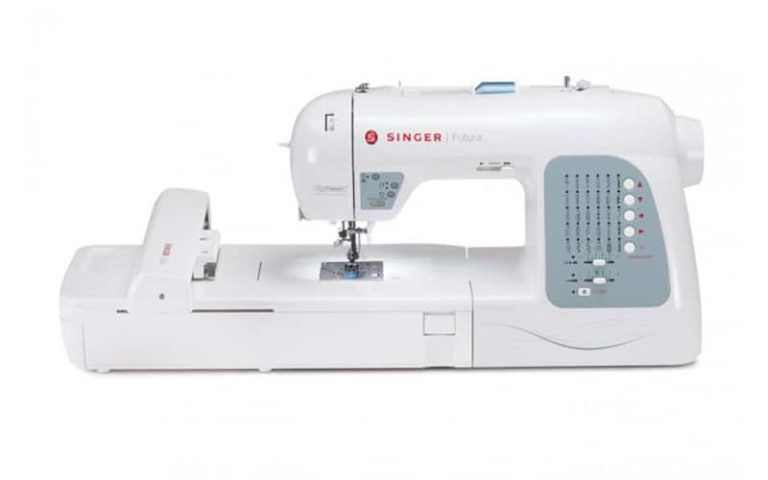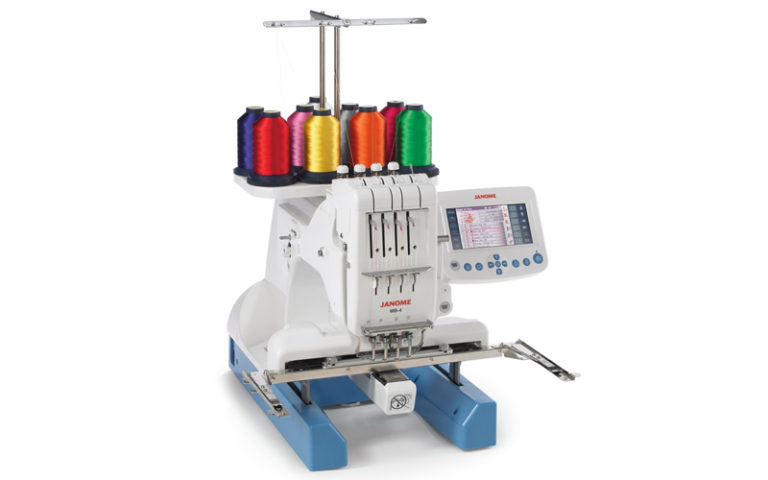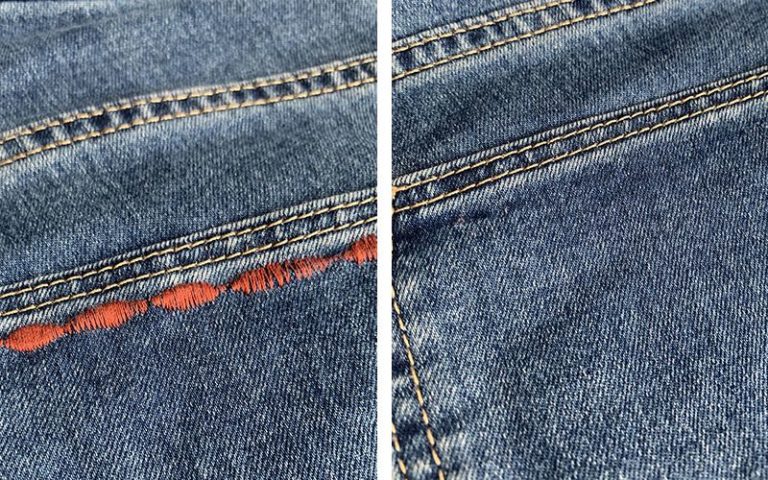If you have tackled sewing and finally hung up your rookie hat, you might be considering learning some basic embroidery stitches.
And if you aren’t considering it, you should be!
Embroidery is an excellent skill that can enhance the look of any sewing project and is something that all sewers should know.
Don’t know where to start? Check our tips for embroidery beginners.
9 basic embroidery stitches
Embroidery is fairly easy to learn and can be narrowed down to nine basic stitches. Let’s take a look at what they are, how to do them, and when to use them.
1. Running stitch
The running stitch is the most basic embroidery and hand sewing stitch to learn. It is a good all-purpose stitch that is great for outlining and decorative work. You can also use it for fun hemlines on your sewing projects.
To make the running stitch:
- Start from the front and simply push the needle through to the back of the fabric.
- Push the needle through to the front again a short distance down your working line.
- Continue this in and out motion until you reach the end of your line.
The finished stitches should look like a dashed line. You can play with your results by changing the length of your stitches and the distance between them.
Still confused? The video below should help clear it up.
2. Backstitch
Backstitch is an outlining stitch that works great when you need a solid line. Using it as a fill stitch can also give you an interesting look.
To make the backstitch:
- Make a forward stitch by starting at the front and bringing your needle down the back of the fabric.
- Go slightly down the line you’re working and bring the needle up to the front.
- Finish your second stitch by going through to the back of the fabric at the end of your previous stitch.
Make the stitches as flush as possible. It’s best if the end of your first stitch and the beginning of your second stitch share a hole through the fabric so that there is no gap between them. This is what gives you the look of a continuous line.
Here is an additional tutorial of the process. In case you need a little extra clarification, you can also watch a video below.
3. Split stitch
The split stitch creates a solid, unbroken line that is much thicker than backstitch. It is excellent as an outline or fill line because of its width. It has a unique braided look texture that can give your project a more sophisticated look than some of the more basic stitches.
To make the split stitch:
- Make a forward stitch by starting at the front and bringing your needle through to the back of the fabric.
- From the back, bring your needle up the front by going through the middle of your first stitch. Your needle should split the fibers of your floss so that an equal number of threads frame each side of the new stitch.
- Finish the stitch by putting your needle to the back of the fabric the same distance down your working line as your initial stitch.
- Continue the pattern by sewing through the center of each previous stitch.
If you are still uncertain, this tutorial and the video below give step by step instructions for making a perfect split stitch.
4. Seed stitch
Seed stitch is a decorative stitch that works very well as a filler if you have too much blank space in your composition. It is one of the easier stitches to do and its confetti-like appearance can add a bit of whimsy to any project.
To make the seed stitch:
- Make a forward stitch by putting your needle to the back of the fabric from the front.
- While at the back of the fabric, choose a spot slightly off from your last stitch and bring the needle up the front again at a different angle.
- Continue making more straight stitches, all at different angles until you have a group of them together.
You can experiment with the length of your stitches, the amount of space between them, and even using different lengths of straight stitches in your project to create different looks.
Still not sure how to do it? The video tutorial below should give you a better idea of how to make a seed stitch.
5. Chain stitch
The chain stitch is yet another outlining stitch that creates a thick, dense line. It is more decorative than the other outlining stitches we have looked at so far, and it is best used in intricate designs.
To make the chain stitch:
- Start your thread from back to front.
- Put the needle through the same hole in your fabric to send it down the back. Don’t pull your thread completely through, so that you have a small loop left on the front side of your fabric.
- Move your needle one stitch length down your working line and then push your needle to the front of the fabric.
- Go through the loop you created in the last step and pull the thread taut, but don’t pull the stitch so tightly that you deform it.
- Put your needle back through the same hole your thread is currently feeding from and leave another loop.
- Continue the pattern until you have finished your line.
If you need a visual aid for this one, the video below gives a full demonstration of how to do a chain stitch.
6. Feather stitch
The feather stitch is a variation of the chain stitch that creates an intricate line best suited for embellishment and decoration. It is by far one of the more complicated embroidery stitches to work, but its interesting-looking design makes it worth the extra effort.
For this one, you have to be a bit more organized than our previous stitches. The feather stitch is easiest to do when it is worked as a straight line, especially when you are a beginner. It is also helpful to draw four lines on your fabric as a guide for your stitching.
To make the feather stitch:
- Pull your needle up the front of the fabric at the bottom of your last line.
- Move your needle two lines over and push the needle down the back. This creates a vertical straight stitch, but you will need to leave the thread loose so you have a loop on the front side of the fabric.
- Move your needle to the line in between your loop, slightly further up the line than your previous stitch.
- Push your needle to the front of the fabric, and make sure it goes through your loop.
- Pull the thread taut and the loop should form into an arrow shape.
- Move the needle to the first line and push to the back, making another vertical straight stitch. Do not pull your thread completely through so that you have another loop.
- Push the needle back to the front of the fabric along the line in between your loop, making sure that the needle goes through the loop again.
- Pull the thread taught to finish your second stitch.
- Start your third stitch by putting your needle down the back through the last line.
- Continue the pattern until you reach the end of your working line.
Let’s be realistic here: the feather stitch needs a visual component to make any sense whatsoever, so check out the helpful video below to give you a better idea of the process.
7. Satin stitch
The satin stitch is a filler stitch that is meant to give shapes a smooth, raised texture with little to no gaps in the fill. With the satin stitch, you can easily create shapes and details in your project.
You will need some sort of template of the shape you want to create. The easiest way to do this is to draw your intended design directly onto your fabric.
To make the satin stitch:
- Start from either the left or right edge of your design. Pull your needle up through the front of the fabric at the top of your shape.
- Push the needle to the back of the fabric at the bottom of your shape. This should give you a long straight stitch.
- Push your needle up the front at the top of your shape and down the back at the bottom of your shape. This stitch should be right next to your previous stitch so that there is no gap in the fill.
- Continue following the lines of your shape until it is completely filled in. If you put too much distance between one stitch and the next, go back to fill in the gap with an additional stitch.
The video below is a great resource for learning the satin stitch, so be sure to check it out before you start your next project.
8. French knot
The French knot is an accent stitch that adds a bit of decoration to your project. They form what look like little rosettes on the surface of your fabric. Like the seed stitch, French knots are typically used in small clusters to fill in empty space.
To make a French knot:
- Start with your needle at the front of your fabric.
- Wrap your thread around your needle twice, ensuring that the needle is in front of the thread. If you try to wrap the needle while it is behind the thread, your French knots will look tangled and lopsided.
- Push the needle down the back next to where the thread is currently exiting the fabric. Keep the thread taut the whole time to keep the coiled thread from slipping off the needle.
- From the back of the fabric, choose where you want to place your next knot and push the needle through to the front.
- Repeat the process as many times as needed.
Even though the French knots seems straightforward, it can be a bit of a pain to get the right technique down. The video below is a good resource to help you learn how to make flawless French knots.
9. Stem stitch
The stem stitch is worked in a similar manner as the split stitch. It works great for making (you guessed it) stems of flowers and plants, so it is especially useful for floral designs.
To make the stem stitch:
- Make a forward stitch by putting the needle up the front and down the back.
- While at the back of the fabric, pull your needle through the middle of your first stitch.
- Instead of splitting the fibers of your thread like in the split stitch, let your needle exit directly beside your first stitch.
- Continue this pattern until you have reached the end of your line.
The stem stitch is super easy once you know what you’re doing, so if you’re still not sure about it, watch the video below for a helpful demonstration of it.
Wrapping it up
There you have it: the nine most useful embroidery stitches that every sewer should learn. They’re super easy and they can add so much character to a sewing project or clothing item.
Once you feel comfortable with the basics, check out these advanced hand embroidery stitches that will help you create interesting textures and more complicated designs.
Still have questions? Ask us in the comment section below.

